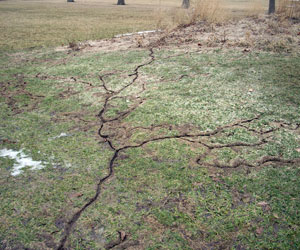What Kind of Damages do Voles do to my Lawn?

Voles are pests mostly found outdoors, which do damage to landscaping. Because voles spend most of their time tunneling underground and feeding off of trees and roots, they can do damage to garden plants and trees, as well as your grass. Voles also multiply rapidly, meaning a problem with one vole can quickly turn into a problem with many voles.
If you have long grass, a number of plants and trees, or large shrubs and bushes, your yard could become an ideal place for voles to hide. They spend time above as well as below ground, chewing on the bark of trees or roots found underground. In large groups, voles can be so destructive that they can kill garden plants and even entire trees.
Voles damage trees in two ways: They eat the bark from the tree in a ring close to the ground, which can affect the tree's ability to protect itself, and they also eat away at the root system. For small trees, this can mean death, as a tree needs its root system to help it draw nutrients from the soil. They can also cause smaller trees or bushes to come out of the ground at the root, meaning a tree may fall over. In addition to damaging the tree itself, this may damage surrounding landscape or even structures if a tree falls into a roof.
If you have plants with bulbs, such as tulips, or plants that grow underground, such as a carrot, you will likely notice voles here first. They tend to eat at the root system or bulbs for these plants, killing them entirely. Once voles enter an area and begin to eat, they are likely to take out an entire garden or set of bushes, shrubs, or flowers. This hurts the natural ecosystem of your lawn and can also be frustrating for you, especially if you planted a garden with the intent to eat it yourself. Since voles are most prevalent in the fall, they can destroy crops easily.
Despite all of these other damages, however, voles do the most damage to lawns. Unlike moles, which leave small mounds of dirt at random intervals, voles dig narrow trenches through the lawn they are inhabiting. This destroys the grass and leaves visible, ugly pathways of dead grass, where seed often needs to be resown in order to make the lawn look right again. Voles will also dig these paths to their nearest food source. The only saving grace is you will have a visible map of where the voles are feeding. Thankfully, this can be re-seeded, but it usually requires waiting until the voles are gone and the growing season has started again.
One little-known risk of voles is that they can carry diseases, as well as fleas and ticks, to household pets. If you suspect you have a vole problem, try to keep your pets away from the infected areas, and make sure they have regular flea and tick guards on them.
Voles can be a problem for the gardener or homeowner, but thankfully, they can often be trapped if you catch them at the first sign of infestation. If you suspect you have a vole, or several, consider having a professional exterminator help you avoid the damages these creatures can cause to the exterior of your home. We can provide you with a free, no-obligation quote from an exterminator in your area, and help you save your hard work so that you may enjoy it, vole-free.